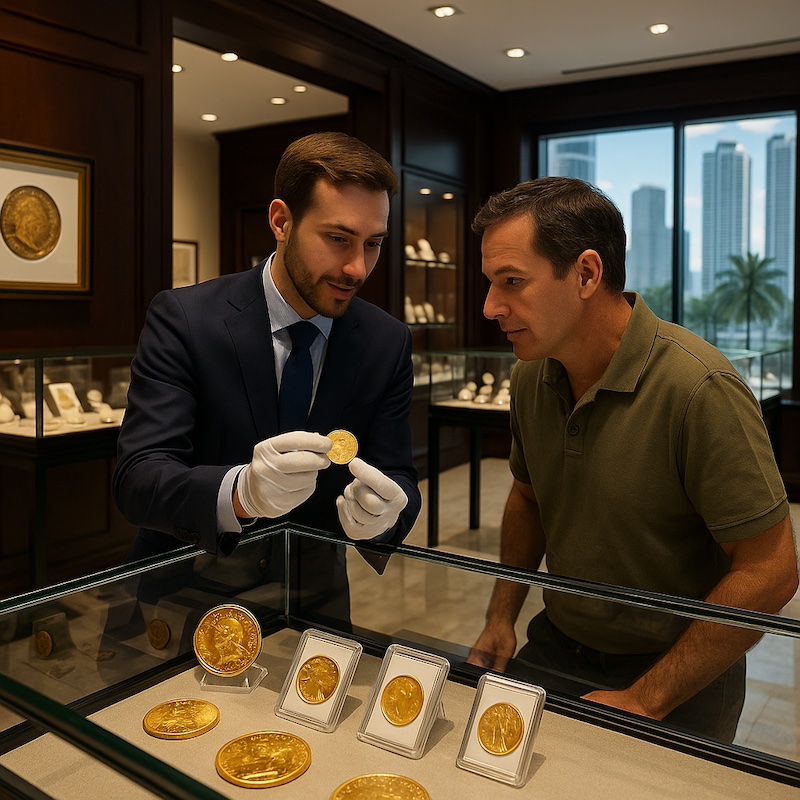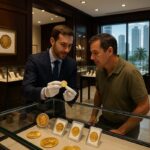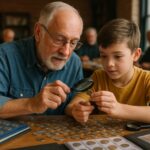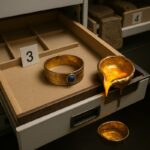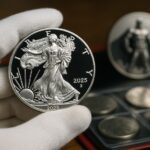If you ask most people what they see in a bowl of spare change, they’ll say “parking meter money.”
Ask a coin collector, and they’ll say “treasure.”
That simple shift in perspective is at the heart of the coin collecting hobby—and it’s one reason the hobby is quietly thriving even as physical cash fades from everyday use. From a fifth-grader searching rolls of pennies to an 80-year-old bidding on a rare Morgan dollar, coin clubs across the United States are proving that numismatics is still very much alive.
At the same time, major changes to U.S. coinage are underway. The federal government has officially decided to stop producing pennies starting in 2026, after years of losing money on each cent it mints. Each penny currently costs around 3.7 cents to manufacture, contributing tens of millions of dollars in annual losses.
For collectors, that decision turns everyday pocket change into a slice of history—especially for those who, like the Fort Dodge Coin Club’s Ed Albright, still enjoy sifting through rolls of cents looking for hidden gems.
TL;DR – Why the Coin Collecting Hobby Still Matters
- The coin collecting hobby spans millions of casual collectors and an estimated 250,000–500,000 active U.S. numismatists, according to recent American Numismatic Association (ANA) commentary.
- Local coin clubs provide community, education, auctions and hands-on access to coins, paper money and tokens.
- Pennies, especially pre-1982 copper cents, remain a fun starting point—just as the U.S. phases out new penny production.
- Coin clubs and national bodies like the ANA help collectors learn, avoid scams, and make more informed decisions about valuation and investing.
- Collecting has both rewards (education, potential value, community) and risks (counterfeits, overpaying, market swings). A balanced, informed approach is essential.
Why the Coin Collecting Hobby Still Thrives in a Digital Age
At first glance, the coin collecting hobby looks like it should be in decline: tap-to-pay wallets, online banking and digital currencies all compete with pocket change. Yet market research suggests the coin collecting market remains robust, bolstered by educational programs, club activities and online resources that draw new participants in.
An ANA blog post by Steve Roach and Dennis Tucker estimates around 250,000 “active” coin collectors in the United States—people who attend shows, belong to clubs, buy books and actively seek out new pieces—while millions more dabble casually.
Why does the hobby persist?
- History you can hold – Every coin is a miniature document of political change, artistic taste and economic policy.
- Treasure-hunt appeal – From wheat cents in pocket change to silver in old jars, the thrill of discovery keeps collectors engaged.
- Community – Coin shows, ANA conventions and local clubs give collectors a reason to meet, trade and learn.
As Tucker notes, people who interact with the broader numismatic community—buying reference books, visiting shops, joining clubs—tend to stay in the hobby longer and gain more from it. blog.money.org
Starting a Coin Collecting Hobby with Pennies
Long-time collector Ed Albright likes to say the easiest way to enter the coin collecting hobby is with pennies. That advice is especially timely today.
Why Pennies Are a Perfect “Gateway Coin”
- Low cost of entry – You can still obtain entire rolls from your bank for face value.
- Historical turning points – In 1982 the U.S. Mint transitioned from nearly pure copper cents to mostly zinc cents with a thin copper plating, due to rising copper prices.
- Multiple varieties – 1982 alone produced several combinations of dates, mint marks, sizes and compositions, creating a rich field for variety hunting.
- Impending end of new pennies – With the government discontinuing new cent production starting in 2026, current coins gain an extra layer of historical interest.
For young collectors, searching a bag of cents with a magnifier and a notebook can be as engaging as any online game—and much better for learning patience, pattern recognition and basic cataloging skills.
Simple Penny-Hunting Checklist
- Look for wheat cents (1909–1958).
- Separate pre-1982 copper cents from post-1982 zinc cents.
- Check 1982 cents carefully for different weights and designs.
- Watch for mis-strikes, doubled dies and off-center strikes that might merit a closer look by a dealer or grading service.
You don’t need to know everything at once. A basic guidebook and a visit to a local coin club will quickly accelerate your learning curve.
How Coin Clubs Turn a Coin Collecting Hobby into Community
The Fort Dodge Coin Club described in the original article is a classic example of what a good local club can be: a family-friendly group where members from elementary-school age to their 80s share coins, stories and knowledge.
Most clubs offer:
- Regular meetings – Often monthly or bi-weekly, featuring show-and-tell sessions and short educational talks.
- Auctions and trades – Low-pressure opportunities to buy and sell at “collector-to-collector” prices.
- Youth outreach – Some clubs run junior auctions or beginner tables where kids can buy starter coins for pocket change.
- Cross-collecting – Many members also bring banknotes, tokens, medals and even metal-detected finds.
The American Numismatic Association actively supports such clubs with educational materials, national promotions and a public directory to help collectors find local groups. American Numismatic Association+2American Numismatic Association+2
“There’s nothing like sitting at a table, passing coins around and hearing the stories behind them,” as one ANA district representative likes to say. “That’s where knowledge and friendships really develop.”
For U.S. coin industry professionals and investors, clubs also serve as an informal “market lab,” revealing which themes, series and denominations are resonating with the next generation.
Beyond Change Jars: Building and Valuing a Serious Collection
At some point, many collectors move beyond pocket change into older or more valuable pieces: bust half dollars, Morgan silver dollars, gold coins, obsolete banknotes and specialized tokens like Civil War store cards or trade tokens.
Balancing Hobby and Investment
Coins sit in an interesting middle ground between collectibles and financial assets. While some pieces do appreciate strongly over decades, others may lag or follow bullion prices rather than rarity.
A prudent approach includes:
- Education first – Study the series you want to collect. Standard references like A Guide Book of United States Coins (the “Red Book”) provide mintages, types and an overview of typical values.
- Condition awareness – Learn basic grading so you can recognize honest wear versus damage or cleaning. Third-party grading services can help with more expensive coins.
- Diversification – Avoid putting all your funds into one coin, one date, or one speculative area.
- Realistic expectations – Treat coins as a long-term, illiquid asset and a source of enjoyment, not a guaranteed short-term profit.
From an EEAT and YMYL standpoint, it’s important to emphasize that this article is educational only. For large purchases, inheritances or estate planning, consult a qualified dealer, appraiser, tax professional or financial advisor.
Basic Options for Coin Collection Valuation
- Price guides and auction archives – Good for ballpark ranges but not a substitute for inspection.
- Local dealers and shows – Useful for real-world offers; get multiple opinions for significant collections.
- ANA-affiliated professionals – The ANA’s dealer directory and consumer awareness resources help identify reputable experts.
Always be cautious about “too good to be true” offers, high-pressure pitches or unsolicited buyout requests, especially online.
Pros and Cons of the Coin Collecting Hobby
Benefits
- Educational value – Teaches history, geography, economics and art.
- Family bonding – Grandparents, parents and kids can share a common project, just like Ed Albright bringing his daughters to club meetings.
- Potential financial upside – Well-chosen coins may hold or grow in value, particularly in scarce series and higher grades.
- Community and networking – Clubs, ANA events and shows introduce collectors to dealers, authors and fellow enthusiasts. American Numismatic Association+1
Risks
- Overpaying – Without knowledge, it’s easy to pay retail for problem coins or overhyped issues.
- Counterfeits and altered coins – Modern fakes can be sophisticated; buying from reputable sources and using third-party grading reduces this risk.
- Market fluctuations – Prices can drop during economic stress or when collector interest shifts to other series.
- Storage and security costs – Safe-deposit boxes, insurance and proper supplies add ongoing expense.
Recognizing both sides helps collectors and investors enjoy the hobby without unrealistic expectations.
FAQ: Common Questions About the Coin Collecting Hobby
1. How many coin collectors are there in the United States?
Precise numbers are hard to pin down, but an ANA blog by Dennis Tucker suggests about 250,000 “active” collectors, with fellow author Steve Roach arguing the number could be closer to 500,000 when you consider proof-set buyers and serious learners. blog.money.org
2. Is coin collecting still worth starting now that pennies are being discontinued?
Yes. In fact, the end of new penny production may make penny collecting even more interesting. With the Mint set to stop issuing new cents from 2026 due to high manufacturing costs, today’s pennies become the final chapter of a 232-year story—prime material for collectors and historians alike. People.com+1
3. What’s the difference between a “collector coin” and a bullion coin?
- Collector (numismatic) coins derive value mainly from rarity, condition and historical interest.
- Bullion coins like modern American Eagles derive most of their value from metal content, though some develop numismatic premiums.
Many collectors own both, but the skill set and market dynamics are slightly different.
4. How can I avoid buying fake or over-cleaned coins?
- Buy from established dealers, ANA member shops or well-known auction houses.
- Prefer coins graded by trusted third-party services for higher-value purchases.
- Learn to recognize hairlines, unnatural color and other signs of cleaning or tampering.
- When in doubt, ask an experienced club member or professional for a second opinion before you buy.
5. I inherited a coin collection. What should I do first?
- Don’t rush to sell. Take time to inventory the collection.
- Sort by metal and denomination. Separate obvious silver, gold or older pieces.
- Consult price guides and ANA resources to understand basic categories.
- Get multiple appraisals from reputable dealers or professional appraisers, especially for large or high-grade collections.
- Consider how the collection fits into your financial and sentimental priorities before making decisions.
Conclusion: Keeping the Coin Collecting Hobby Alive—One Penny at a Time
From Ed Albright’s childhood memories of his grandmother’s lucky penny rhyme to the Fort Dodge Coin Club’s multi-generation meetings, the coin collecting hobby shows that history, art and community can still be found in the smallest denominations.
As the U.S. mints its last pennies and digital payments become the norm, coins are shifting from everyday tools of commerce to curated artifacts of our shared past. That transition makes now an ideal moment for:
- Collectors to deepen their knowledge,
- Investors to balance passion with prudence, and
- Families and educators to use coins as hands-on history lessons.
Whether you’re just starting with a jar of cents or managing a six-figure cabinet of rare U.S. gold, consider visiting a local coin club, joining the ANA, or consulting a trusted professional. The next great story in your collection might be sitting in your change bowl right now—you just have to look closely enough to find it.


